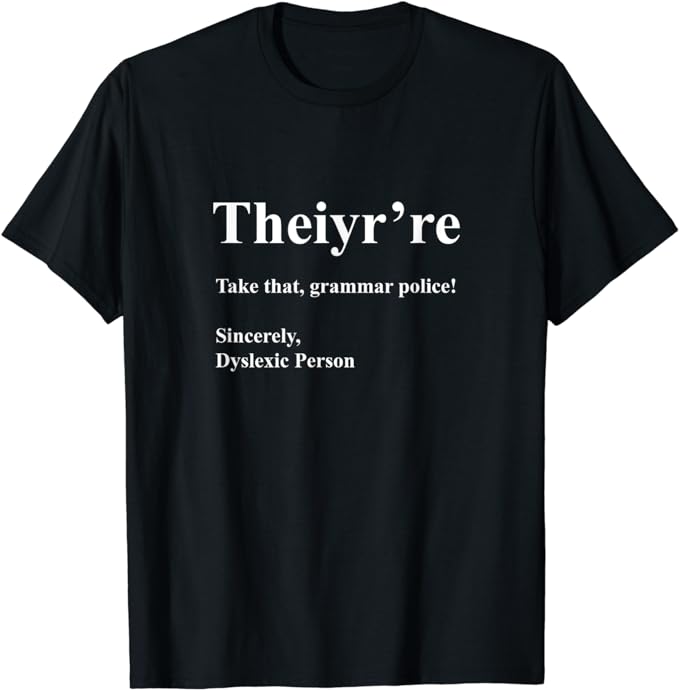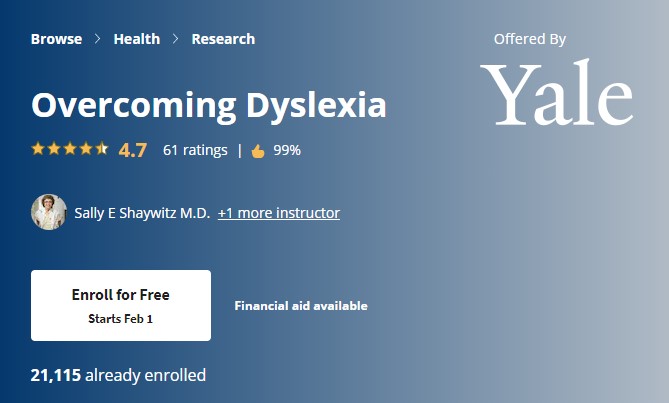
Overcoming Dyslexia offered by Yale University on Coursera with Sally E. Shaywitz M.D.
Updated definition of dyslexia:
An unexpected difficulty in reading, for an individual who has the intelligence to be a much better reader, most commonly caused by a difficulty in the phonological processing (the appreciation of the individual sounds of spoken language), which affects the ability of an individual to speak, read and spell.
It occurs as early as first grade, and persist if no intervention is put in place.
1 in 5 are dyslexic and a lot of them don’t go diagnosed or the identification is late. It’s equal in boys and girls. The optimal age for remediation is Kindergarten – 1st Grade.
Being aware of sounds/phonemes, breaking them down and sounding them out help a lot. Cat will have the phonemes K then aaaa then t. You can use your fingers to break down the phonemes and then sound them out. The decoding part is where the problem is and not the comprehension.
Writing is not a language, but merely a way of recording language by visible marks.
– Leonard Bloomfield, Linguist
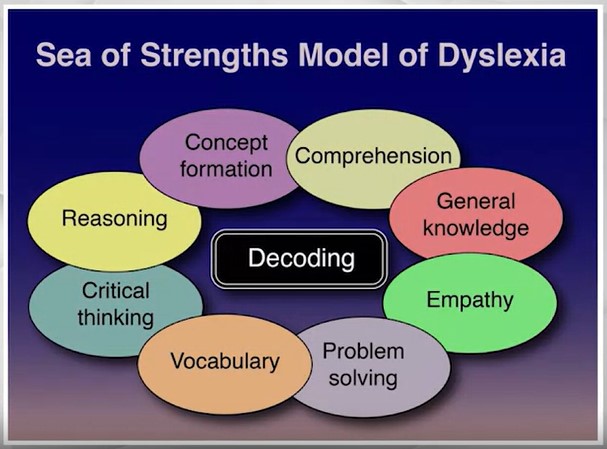
Amazon #ads
The left side of the brain is associated with reading and for dyslexic people there is a glitch. Dyslexic readers use different brain pathways.
Brain imaging is not recommended to diagnose dyslexia.
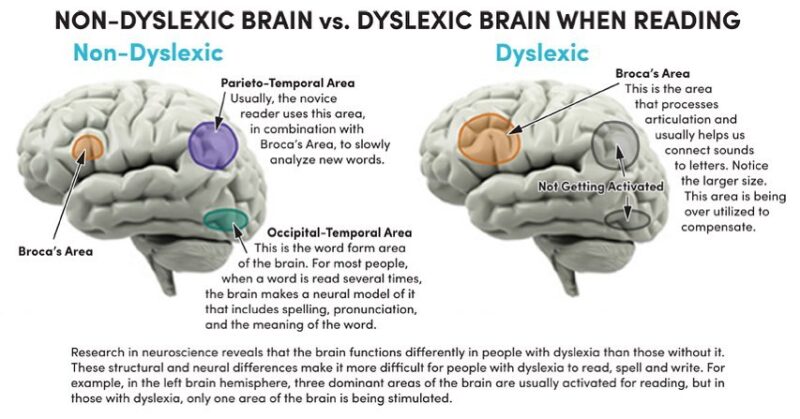
Dyslexia is specific and is not the same as learning disabilities which is a broad term. Slow reading is connected to slow thinking which is not the case. So remember that IQ and reading is not linked at all.
Dyslexics learn how to read with hard work, much practice and resilience.
Reading interventions must be implemented as early as possible. No later than 1st grade! So children must be screened and evaluated as early as possible. One simple way is to listen to your child speak and see if they have difficulty. By 5-6 years they should have little problem saying most words correctly. Children’s familiarity to nursery rhymes and sensitivity to rhymes is another indication. They have difficulty accessing the intended phoneme and will point or show signs of frustration. They’ll replace words they can express with ‘stuff’ and ‘things’, etc. Their listening vocabulary is much larger than spoken vocabulary.
Linking letters to words and sounding them out will help them a lot. They must build their vocabulary and reading will help that. The more a child reads the more they develop neural pathways to better reading. Spelling, pronunciation and meaning get integrated.
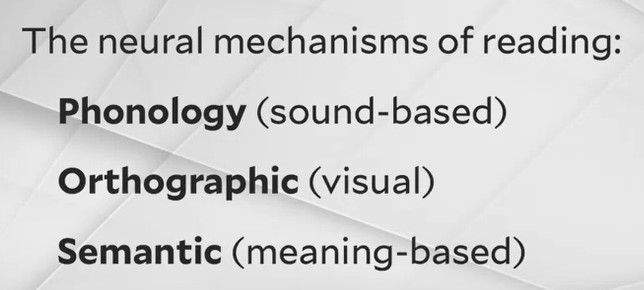
Fluency (reading words quickly, smoothly and with good expression) is acquired by practice and repetition (4 or more successful encounters with a new word). Prosody – the ability to read with meaning or good expression.
In early life a child will learn more from listening and by 7th grade it tips over to more reading. Books offer at least 3 times more interesting or complicated words than the most eloquent speakers. Dyslexic readers generally require many more exposures to a printed word over a much longer period of time before the neural pathways are well-developed and come together each time they encounter that word. In some instances, these connections continue to be less than robust, impeding the ready retrieval of words. As result, even when dyslexic readers are able to decode words accurately, they are still not quick in their reading of these words. So even after recognising the word, the next time they see it they may look at it as if it was the first time they saw it if the context is not the same. They also struggle with small words like and, the, that, in and on.
Weakness
Failure to understand that words come apart.
Inability to learn to associate letters with sounds.
Reading errors that show no connection to the sounds of the letters.
The inability to read common one syllable words or the sounds out even the simplest of words.
Complaints about how hard reading is or running away or hiding when it is time to read.
Strengths
Curiosity.
A great imagination.
The ability to figure things out.
Eager embrace of new ideas.
Getting the gist of things.
Good understanding of new concepts.
A large vocabulary for age.
Enjoying solving puzzles and talent at building models.
Reading growth is maximal in the first few years of school and then it plateaus.
Universal screening is not a diagnosis but it’s a quick way to identify potential issues. Good screeners will be able to identify true positives/dyslexics and true negatives/not dyslexic. It’s advisable to wait until the second semester to have a better picture. Look up Shaywitz DyslexiaScreen Manual (video below)
3 Steps of the Evaluation Process
1 – establish a reading problem according to age and or level of education,
2 – gather evidence supporting its unexpectedness, that is high learning capability may be determined on the basis of an intelligence test,
3 – demonstrate evidence of a phonological weakness with other higher-level language functions, relatively unaffected.
Reading scores are to be looked at for accuracy, fluency and comprehension. Other areas to look at are attention, anxiety, memory, etc. It could be disparity between intelligence and reading. DNA testing is not recommended.
Dyslexic people are still avid readers and enjoy reading especially after learning the Phonemic Awareness to connect letters to sounds and words to spoken words. Teaching children that words rhyme and understand that letters and words break apart and come together will help. Then they can learn about the different sounds with word combinations (phonics). Practice is very important.
Recommended Decodable Text: #ads
– S.P.I.R.E. Decodable Readers, Set 1A – 10 Titles (SPIRE)
– Scholastic Decodable Readers Books 1-88
Sight words or irregular words are the hardest because they do not follow a pattern and cannot be sounded out, therefore must be memorised and recognised. Flash cards are recommended for memorisation.
If you want a reliable program go to What Works Clearinghouse.
The Wilson Reading System is a structured literacy program that features reading connected text in the very first lesson.
Fluency means reading the word accurately and understanding/comprehension. The key factors are:
– Practice oral reading.
– Practice reading connected text repeatedly.
– Provide ongoing feedback as the child reads.
– Reading new material leads to greater growth in reading comprehension.
– Paired reading/Guided oral reading for 15 minutes: Parent reads a short story, parent-child read the story again and child reads alone. MAKE THIS A PRIORITY! (Go at their pace and remember they’re comfortable with books where they can read 19 out of 20 words correctly).
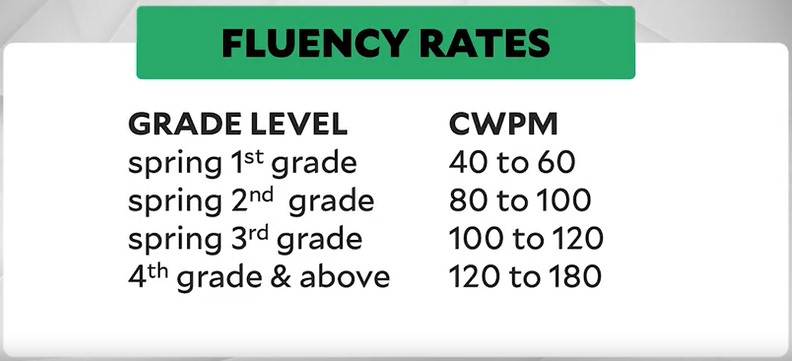
Measure correct words per minute during reading a short passage and getting instructions in small groups instead big classes.
Prosody – Reading with inflection, speed and tone reflecting the meaning of the passage. (Guide and teach if necessary)
Parents can enforce useful rules at home such as:
– The secret of the silent e rule.
– Saying C’s (soft vs hard).
– Taking apart compound words.
– Two consonants surrounded by two vowels.

Early vocabulary is the best predictor for reading comprehension in later grades and this comes down to parent-child interaction.
It is important for dyslexic children to learn Tier 2 vocabulary since Tier 1 is pretty common. Good words ‘stretch’ but not too far. They are frequent enough. Introduce 10 new words every 1-2 weeks. Reading aloud at a young age will build vocabulary.
Tier 1 – consisting of common words found in oral language.
Tier 2 – consisting of words found in written language which are of high-utility.
Tier 3 – consisting of words that are limited to specialized domains, such as law, medicine, and archaeology.
Direct and explicit instruction will help encourage writing. Teaching Basic Writing Skills #ads
The number one goal is the preservation of the child’s self-esteem. Let them know their difficulty has a name and it will be helped. No matter what they can count on their parents and be unconditionally loved and supported. Remind them of their value and there is a bigger picture where they have an important role to play. Remind them of the sea of strengths and how they’re smarter in so many ways. Show them this post. Motivate and support them to do things they love and enjoy. Praise often and encourage to read out loud, speak up for themselves and get better at expressing using words.
Critical Elements/Finding the Right School:
– Climate is the most important. Are they comfortable or is it an unwelcoming climate where they feel stupid.
– Good climate would look like: Proper instruction, qualified teachers, small groups, needs met, integrated learning, boost in self-esteem.
– Is the school aware of dyslexia and do they provide accommodations? They should not assume slow reading = slow thinking.
– Special education doesn’t really mean it’s right for dyslexic school.
– Consider changing schools if – no progress in current school, no effective reading program, no providing promised services, lack of understand, causes child to begin negative behaviours.
– Private school may prioritise tradition and uniformity over unique learning needs.
– Teachers being well-equipped to teach through preparation, implementation and evaluation.
– Windward School and Park Century School emphasise on early identification. They setup more literal art classes, they focus on helping students to self-regulate, self-advocate and self-monitor.
– Laura Cassidy started LKA (Louisiana Key Academy) – focus on children not having a sense of shame or being different and the sea of strengths model.
– Remember Screening is not equal to Assessment. Screening is first and has a set list and then a detailed assessment is performed. The screening program should be evidence-based with proven validity, efficient, low-cost and readily available.
3 Things to Consider when Planning for College (This should begin in 9th-10th grade)
– Academics: Increase independence and autonomy. What do they enjoy and their interests. Self-esteem and self-advocacy are crucial. Failing is not a bad thing and failing again will help resilience. Sharpen student skills and attitude. What skills are needed to improve reading and education e.g. text to speech, speech to text. Children should be judged separately for spelling/grammar and creativity/imagination. (Special thanks to my teach Susan DeSouza for doing that with me). Some schools may lower expectations but that is not what is needed as it will be less rewarding. They need support with high expectations.
– Organisational Skills: High school should be seen as a prep school. Time management – keep a schedule, make time for yourself, master long-term projects and think of taking one bite at a time on the large ones.
– Personal Focus: Receiving personal accommodations. Understand and adapt to the dyslexia. Role-play and understand it has weaknesses and also strengths. Clarify psychological issues like anxiety, ADHD and other co-occurring disorders.
Helping Adults Become Better Readers:
– Discipline and high-level work ethic.
– Persistence with take you far.
– Enroll in a literacy or tutoring program.
– Know that it’s never too late to improve your reading skills.
It is very common to have anxiety and/or ADHD with dyslexia.
Anxiety:
– Virtually all dyslexics have anxieties.
– Related ones are social anxiety disorder and panic disorder.
– Retrieval becomes harder with anxiety.
– Taking medication to deal with this should not be seen as a sign of weakness. SSRI/SNRI will take 4-6 weeks to go into effect and may have side-effects.
ADHD:
– Cognitive Behavioral Therapy is very helpful for ADHD. More info here.
– Graded desensitisation is recommended.
– Adderall combined with CBT is recommended. Other medication is recommended and come with side-effects sometimes.
– Mindfulness practices is recommended.
– Never let these diagnosis define you.
– There is a very large connection between comorbidity of dyslexia and ADHD.
– 3 Cardinal symptoms: Inattention, impulsivity, and hyperactivity.
– 3 types of ADHD: Inattentive, Hyperactive-impulsive and combined.
– Things you can do are – schedules, rewards, goals, checklists, extra time, physical activity, sitting closer to the teacher.
Related Links:
– Top 15 ADHD Behaviours You May Not Know You Do
– How you Treat ADHD Based Off Science – Dr. Russell Barkley
Technology
– Teach your child to touch type as soon as possible. (Paras note: I’m so grateful that I got access to Mavis Beacon around the time I was getting better at reading and comprehension.) #ads
– Text to Speech apps and software helps a lot but children don’t need this straightaway. Other tools are Livescribe Smartpen, OneNote, Evernote, Notability.
– Digitized Books: Bookshare, Learning Ally, Project Gutenberg, Google Books.
– Text to Speech apps: Immersive Reader, Voice Dream Reader, Kurzweil Firefly, Read and Write Gold, Read:Aloud, Seeing AI.
– Speech to Text: Dictate, Dragon, Otter.ai, Descript, Rev.
– Other tools: Quizlet, Cliffnotes, Textbook scanning services.
– Vocabulary apps: Fry words (& Ninja), Sigh Words, Wet Dry Try, Partners in Rhyme, OG Card Deck, Headsprout, Lexia Core5 Reading.
Crucial Accommodations
– Extra/additional time is crucial and should be obligatory for dyslexic students. It takes more effort and time to comprehend. Never feel guilty for requesting extra time. Each person will require their own time and even with extra time the student will feel the pressure of time.
– Dyslexic people struggle with foreign languages so they can request a partial waiver for foreign language requirement in which the student can study foreign culture, politics, literature and/or history but in English.
– Have textbooks digitised and provide text to speech technology. Find related movies or materials that help. Find ways to visualise the information e.g. flowcharts and flashcards. Software WebspirationPro. Record your lectures so you can play them back.
– Classic/instrumental music will help you block out distractions as dyslexic brains work differently and are not automatic readers.
– Select courses that don’t have too much reading or focus on meaning and concepts instead of details.
SQ3R Method:
Survey: Look over the reading, chapters, titles and summaries.
Questions: Change headings into questions and let them guide your reading.
Read: Search for the answers and actively highlight, underline and take notes.
Recite: Say your answers out loud.
Review: Go over main points of notes taken and recite out loud. (Paras note: This is basically what I figured out on my own and why I have a blog summarising books, courses and so much more!)
Dyslexia in College and Graduate Students
– Lack of fluency when reading aloud is the only true sign of dyslexia in a bright adult. Do they read with prosody.
– As the person grows they’re find it easier to read.
The Step Act was passed in 2018 to mandate a dyslexia screening program including a) evidence based with proven psychometrics for validity, b) efficient and low cost, c) readily available.
The Americans with Disabilities (and it’s amendment act) (ADAAA) Act provides for accommodations on standardized tests and prohibits discrimination based on a persons disability.
The Rehabilitations Act found section 504 provides children with accommodations if an Individual Education Plan can’t be provided.
Under the IDEA (Individuals with Disabilities Education Act) Act requirements a child must have a disabling condition and impact of the condition must create a need for special education services to be eligible to qualify for an IEP (Individualized Education Program).
20% of students are dyslexic yet only ~2% asked for accommodations and a lot of the teachers don’t give them under the claims of the student trying to game the system or misinterpreting the rules and laws. Just because a dyslexic person has found self mitigating measure to deal with their dyslexia does not mean they don’t still need accommodations. There is are lots of laws and changes constantly changing to support dyslexic people.
What to remember about Dyslexics:
– Think differently, Intuitive and excel in problem solving,
– Seeing the bigger picture and simplifying,
– Abstract and out of the box thinkers, Inspired visionaries,
– Tough because of their struggles and persevere through adversity that others haven’t had to face,
– Most are lucky to have someone recognise their struggles and/or talent,
– Don’t give up!
Course Overview
| Level | Beginner |
| Commitment | 8 weeks of study, 2-3 hours per week |
| Language | English |
| How To Pass | Pass all graded assignments to complete the course. |
| User Ratings | Average User Rating 4.7 |
Syllabus
Week 1 What is Dyslexia?
In module one, we’ll cover the basics. What is dyslexia? What is reading? How does a dyslexic reader differ from an “automatic” reader? We’ll take some time to talk about the 100+ year history of dyslexia and reveal how much progress modern science has made in understanding what goes on in the brain of a dyslexic reader.
10 videos, 2 readings, 12 question quiz
- Video: Course Introduction
- Reading: Meet the Faculty
- Reading: The Book (Amazon #ads link: Overcoming Dyslexia)
- Video: 1 What is Reading
- Video: 2 History – part 1
- Video: 2 History – part 2
- Video: 3 Who is Affected by Dyslexia? – part 1
- Video: 3 Who is Affected by Dyslexia? – part 2
- Video: 4 Understanding The Why – part 1
- Video: 4 Understanding The Why – part 2
- Video: 5 The Brain’s Role in Dyslexia – part 1
- Video: 5 The Brain’s Role in Dyslexia – part 2
Week 2 Screening, Evaluating, and Diagnosing Dyslexia
How does one know if they, or their child, is dyslexic? Module two examines the origin of the difficulties in dyslexia: getting to the sounds of spoken language. . We’ll talk about the paradox of dyslexia: a circumscribed deficit in decoding surrounded by a sea of strengths in higher cognitive function. We’ll examine when, how, and why to begin screening and testing children for dyslexia and what signs primary caretakers and teachers should be on the lookout for in their children and students at risk for dyslexia.
7 videos
- Video: 6 Diagnosing Dyslexia – part 1
- Video: 6 Diagnosing Dyslexia – part 2
- Video: 6 Diagnosing Dyslexia – part 3
- Video: 7a Should My Child Be Evaluated for Dyslexia?
- Video: 7b How Does a Child Make Progress?
- Video: 7c How to Screen for Dyslexia
- Video: 7d How to Diagnose Dyslexia
Week 3 Effective Interventions for Young Children
Here we examine the many facets of providing the most effective interventions for dyslexic children. Included are interventions for the beginning reader such as teaching phonemic awareness and phonics. Teaching fluency, vocabulary and comprehension follow as well as strategies that encourage and preserve the child’s self-esteem. Throughout we emphasize the critical importance of employing evidence-based interventions.
9 videos
- Video: 8a What are the Best Interventions for Dyslexic Children? – part 1
- Video: 8a What are the Best Interventions for Dyslexic Children? – part 2
- Video: 8b How Do We Know If a Reading Program is Effective? – part 1
- Video: 8b How Do We Know If a Reading Program is Effective? – part 2
- Video: 8c How Does a Dyslexic Child Make Progress in Their Communication Skills? – part 1
- Video: 8c How Does a Dyslexic Child Make Progress in Their Communication Skills? – part 2
- Video: 8c How Does a Dyslexic Child Make Progress in Their Communication Skills? – part 3
- Video: 9 How Do You Take Care of The Whole Child? – part 1
- Video: 9 How Do You Take Care of The Whole Child? – part 2
Week 4 Choosing the Right School for Your Dyslexic Child
We survey and examine public schools, independent schools and schools specialized for dyslexia and when parents of dyslexic children might consider changing their child’s current school. The pros and cons of each type are examined with an emphasis on choosing a school where the climate for dyslexic children is welcoming. Two private independent schools and a public charter school specialized for dyslexia are examined In depth, focusing not only on their reading programs but how these specialized schools preserve and protect the dyslexic child’s self-esteem, promising and most often fulfilling the dyslexic graduate with an opportunity to succeed in high school, college and in life.
9 videos
- Video: 10a Finding the Right School for Your Child – part 1
- Video: 10a Finding the Right School for Your Child – part 2
- Video: 10a Finding the Right School for Your Child – part 3
- Video: 10b Thinking About a Specialized School – part 1
- Video: 10b Thinking About a Specialized School – part 2
- Video: 11a A Closer Look at Specialized Schools – part 1
- Video: 11a A Closer Look at Specialized Schools – part 2
- Video: 11b Laura Cassidy and LKA – part 1
- Video: 11b Laura Cassidy and LKA – part 2
Amazon #ads
Week 5 Preparing for College and Adulthood
Here we use life histories of dyslexic individuals to illustrate how despite their difficulty in reading, by using their sea of strengths and incredible resilience, dyslexics can and do succeed in a wide range of careers and professions. Beginning in adolescence, a focus on academics and organizational skills paves the way to success in college and their perseverance and creativity auger well for their success in the workplace. Through the stories of successful dyslexics we emphasize how critical it is that dyslexic children and young adults know that they can succeed and should be encouraged by their parents, teachers and guidance counselors to pursue their dreams.
8 videos
- Video: 12a How Do Dyslexic People Succeed in Life? – part 1
- Video: 12a How Do Dyslexic People Succeed in Life? – part 2
- Video: 12b How to Get Ready for College – part 1
- Video: 12b How to Get Ready for College – part 2
- Video: 13a How Can Adults with Dyslexia Become Better Readers? – part 1
- Video: 13a How Can Adults with Dyslexia Become Better Readers? – part 2
- Video: 13b How Much Reading is Involved? – part 1
- Video: 13b How Much Reading is Involved? – part 2
Week 6 Comorbid Conditions
Anxiety and ADHD are the most common comorbid disorders co-occurring with dyslexia, anxiety observed in nearly all and ADHD seen in half of children and adults with dyslexia. Through two case histories the subtypes of anxiety (including social anxiety and panic disorder) and the subtypes of ADHD (inattentive, hyperactive-impulsive, combined) as well as their symptoms are reviewd. Effective pharmacologic and non-pharmacologic interventions (cognitive behavioral therapy, CBT, and mindfulness) are reviewed. We emphasize the critical importance of recognizing and treating comorbid anxiety and ADHD in the child and adult with dyslexia.
4 videos
- Video: Lesson 14a Anxiety – part 1
- Video: Lesson 14a Anxiety – part 2
- Video: Lesson 14b ADHD – part 1
- Video: Lesson 14b ADHD – part 2
Week 7 Assistive Technologies and Accommodations
Dyslexic students and dyslexic adults have come to depend on using technology within a framework of critical accommodations to allow them to succeed not only in school but in their careers and professions. We focus as well on the use of text to speech technology and the accommodation of partial waivers for the foreign language requirement in college and graduate school. In particular we review the rationale including the neural basis for the life-changing accommodation of extra time, especially critical for high stakes, gate-keeper standardized tests.
8 videos
- Video: 15 How Can Technology Assist the Dyslexic Reader? – part 1
- Video: 15 How Can Technology Assist the Dyslexic Reader? – part 2
- Video: 16a What Are the Most Critical Accommodations? – part 1
- Video: 16a What Are the Most Critical Accommodations? – part 2
- Video: 16b What Can a Dyslexic Student Do to Succeed in College? – part 1
- Video: 16b What Can a Dyslexic Student Do to Succeed in College? – part 2
- Video: 16c How is Dyslexia Identified in College and Graduate Students – part 1
- Video: 16c How is Dyslexia Identified in College and Graduate Students – part 2
Week 8 The Law
In these lessons we note the federal definition of dyslexia as “an unexpected difficulty in reading for an individual who has the intelligence to be a much better reader” and review three relevant federal statutes affecting interventions and accommodations for dyslexic students: IDEA, ADAAA, and section 504. We note the concept of condition, manner and duration as detailed in the ADAAA and in the DOJ Final Regulations of that law. We review how the ADAAA has been applied in cases of dyslexic medical and law students requesting accommodations and how dyslexic applicants for high stakes standardized tests no longer suffer the effects of flagging their scores as invalid.
9 videos
- Video: 17a What Legal Protections are Available to Those with Dyslexia? – part 1
- Video: 17a What Legal Protections are Available to Those with Dyslexia? – part 2
- Video: 17b How Should Disabilities Be Compared to the General Population – part 1
- Video: 17b How Should Disabilities Be Compared to the General Population part 2
- Video: 17c How are Requests for Accommodations Typically Being Responded to? – part 1
- Video: 17c How are Requests for Accommodations Typically Being Responded to? – part 2
- Video: 17d What Happens When There is a Violation of the Law? – part 1
- Video: 17d What Happens When There is a Violation of the Law? – part 2
- Video: 17d What Happens When There is a Violation of the Law? – part 3
Week 9 What to Remember
Video: 18 What to Remember about Dyslexia
